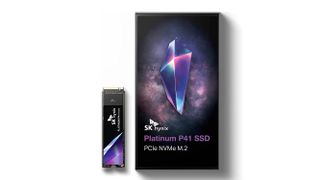SK Hynix's New SSD Boasts 1.4 Million IOPS
Well over 1 Million IOPS

SK hynix has released a brand new PCIe Gen 4 SSD known as the Platinum P41, featuring capacities of up to 2TB and sequential speeds of up to 7000MB. However, its most prominent selling point is that it's rated for 1.4 million random read IOPS and 1.3 million random write IOPS, which would make it one of the fastest SSDs on the market.
For some perspective, the best SSDs right now usually top out at around 1 million IOPs for random reads. The WD Black SN850 (2TB) achieved just over 1 million on our tests (at 4K QD 256 Q16T16) while the Kingston KC3000 (TB) hit 1.57 million IOPS in random writes (4K QD 256 Q16T16). So, if the Platinum P41 lives up to its claims, it would have a really strong combination of random read and write IOPS though not necessarily the fastest writes.
This additional performance headroom could be very beneficial in the consumer space. Many workloads benefit significantly from random reads and writes, since data is often thrown everywhere on a drive's NAND flash and isn't neatly organized in one space. This problem is often what bottlenecks an SSD's sequential read and write speeds since the SSD has to both transfer data and find the data simultaneously. This means the faster an SSD can read or write to these random locations, the faster it should be overall.
SK hynix achieves these claimed speeds with its new 176-layer NAND flash; the Platinum P41 is the first consumer-based drive to use this technology. Announced two years ago as an upgrade from its 128-layer NAND, the 176-layer memory promises a 20% increase in read cell speed and up to 1.6GT/s of bandwidth between the flash and the SSD controller.
The SK hynix Platinum P41 is already available to purchase from online retailers such as Amazon and comes in three capacities. A 500GB model for $104.99, 1TB for $149.99 and 2TB for $259.99.
It's rated for maximum read speeds of up to 7000 MBps on all the drive models (thanks to the 7GBps limitations of PCIe Gen 4.0); however, the write speeds do vary depending on the capacity. The 500GB model peaks at just 4700 MBps , while the 1TB and 2TB models peak at 6500 MBps. The same situation applies to the SSD's lifespan, with a maximum of 1,200 TBW for the 2TB model, 750TBW for the 1TB model, and finally 500TBW for the 500GB version.
It's worth noting that we don't know the exact random read and write speeds for each individual SKU. However, since the 500GB version comes with a sequential write penalty of 4700 MBps, it's safe to presume this lower-end model will also suffer a sequential read and write penalty too. The same could even be true of the 1TB model, but we can't be sure.
Stay on the Cutting Edge
Join the experts who read Tom's Hardware for the inside track on enthusiast PC tech news — and have for over 25 years. We'll send breaking news and in-depth reviews of CPUs, GPUs, AI, maker hardware and more straight to your inbox.
We will have to see how the drives really perform in testing, but it appears that SK hynix's Platinum P41 SSDs could be among the fastest we've seen so far in the consumer space.

Aaron Klotz is a freelance writer for Tom’s Hardware US, covering news topics related to computer hardware such as CPUs, and graphics cards.
-
Alvar "Miles" Udell For reference, the Samsung 980 Pro 2TB is $269.99 at Amazon. It will be interesting to see how this drive stacks up against it in reviews.Reply
I say this as someone who is in the market to replace 2 smaller Samsung 960 Pros with a single 2TB 980 Pro. -
drajitsh Why are current generation SSDs so low on endurance vs the last gen. For example 750 TBW Vs 1400 or more in msi spatium 470Reply -
edzieba Exiting for datacentres running high concurrent usage DBs (who would likely not be seen dead running one of these drives and are instead lapping up every Optane die they can get), but what does its IOPS performance look like at the QD1 queue depths seen with desktop workloads?Reply -
jp7189 Reply
The more bits stored per cell the higher chance of error. The intrinsic problem moving from TLC to QLC is actually worse than the numbers suggest, but is improved by better error correction techniques.drajitsh said:Why are current generation SSDs so low on endurance vs the last gen. For example 750 TBW Vs 1400 or more in msi spatium 470 -
drajitsh Reply
Both drives are TLC. I am currently not interested in QLC drives. I would only consider a QLC drive if it is 10c/GB or less for a drive with DRAM.jp7189 said:The more bits stored per cell the higher chance of error. The intrinsic problem moving from TLC to QLC is actually worse than the numbers suggest, but is improved by better error correction techniques.
Most Popular



